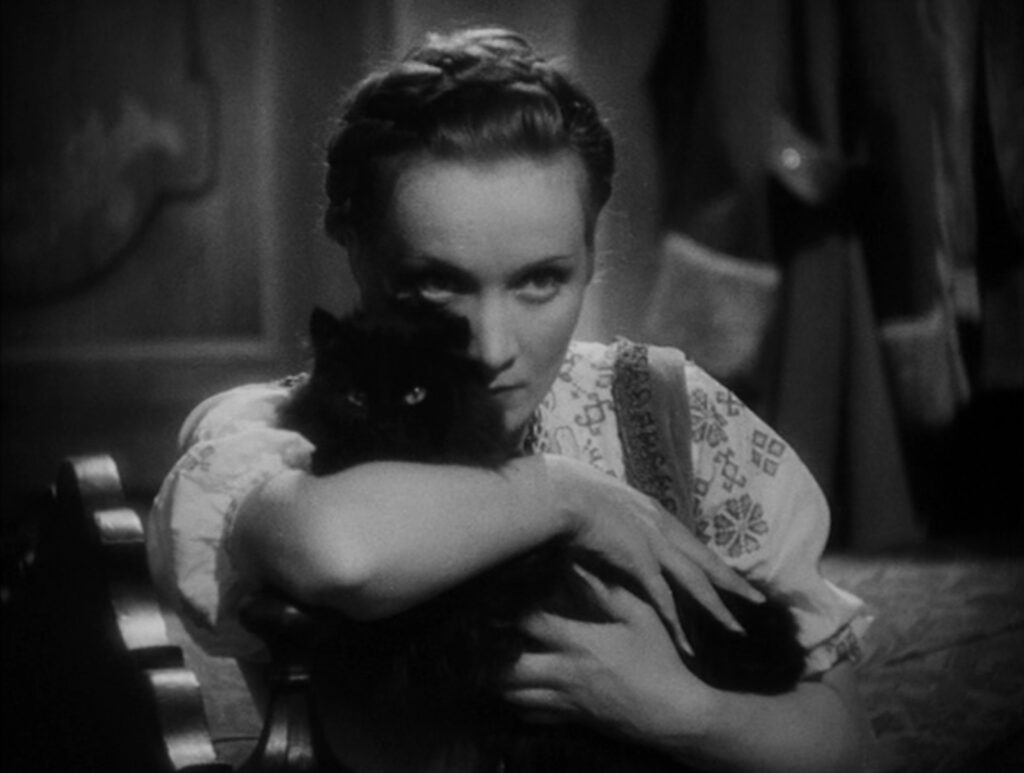
Josef von Sternberg’s pre-code spy romance Dishonored (1931) sees his muse Marlene Dietrich as a Mata Hari type of character spying on the Russians for Austria during WWI. Josef von Sternberg directed, produced, scored, edited and co-wrote Dishonored as his third film with Dietrich and their second for Paramount. The director’s stylized romanticism is further refined as is the image of Dietrich as a subversive figure of contemporary gender depictions.
Dietrich was an object of desire in von Sternberg’s The Blue Angel (1930); then the love interest in Morocco (1930); but by Dishonored Dietrich has transformed herself into a wholly unique cultural phenomenon and leading lady to rival Garbo. With her cat as her sidekick, Dietrich’s Agent X-27 dons men’s clothes and seductive gowns alike as the super spy navigates a game of cat and mouse with Russian spy Victor McLaglen. Dietrich, like her character, possesses tremendous agency and power as the hero of Austria. Dietrich arrived with The Blue Angel but she conquered the hearts of audiences with Dishonored.
The complex and subversive image of Dietrich is von Sternberg’s greatest asset in his reimagining of the espionage thriller as a tragic “weepie”. von Sternberg’s native Vienna is rendered as a mystic space of European decadence and duplicity on the sound stages of Paramount. The exacting lighting schemes and blocking in Dishonored amplify the sensuality of the spaces and the glamorous secret agent who inhabits them. von Sternberg pushes himself as a filmmaker like never before to concentrate every aspect of the film around its central character to paint a vividly romantic portrait of a Europe that went extinct with the Bolshevik revolution in Russia.
For as much as Dishonored reinvents its genre conventions and showcases the iconoclastic Dietrich, it is also a love letter to a Vienna lost to the sands of time. von Sternberg’s hyper reality, born of the opera houses of Europe and the celebrated avant-garde films of the early twenties, presents an idea of Vienna grounded in emotional atmosphere and ambience rather than concrete physical spaces. There is a dreaminess to Dishonored that would reach its zenith in The Scarlet Empress (1934) where depictions of pre-war Europe take on fairytale proportions.
Of the films produced in the thirties inspired by or based upon the exploits of Mata Hari Dishonored is the most stylistically sophisticated if not the most affecting. von Sternberg’s film predicts the modernist evocations of the spy films of the sixties with its balance of style and uninhibited female sexuality. Clearly Mario Bava and Joseph Losey both studied Dishonored and appropriated its sensitive balancing act of von Sternberg’s unreal style and the very human impulses of Dietrich. Of the cycle of films that Dietrich and von Sternberg made together, Dishonored has been the most consistently undervalued.
